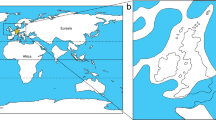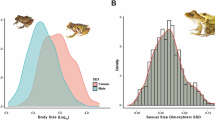Abstract
Arising from: J. J. Head et al. Nature 457, 715–717 (2009)10.1038/nature07671; Head et al. reply
Palaeotemperatures can be estimated from characteristics of fossils if their living relatives represent the full evolutionary potential of the larger taxon to which the fossil belongs. By drawing on observations1,2 that the body size of poikilotherms decreases globally with ambient temperature, Head et al.3 used the 13 m length of the newly described fossil boid Titanoboa cerrejonensis to estimate that the Palaeocene neotropical mean annual temperature (MAT) was 30–34 °C. I question the validity of this palaeotemperature estimate by using the same data and approach as Head et al.3 to show that Varanus (Megalania) prisca4, a large extinct lizard that lived in eastern Australia during the Late Pleistocene, was 3–4 times longer than predicted by the largest lizard species in the tropics today. This suggests that the scarcity of large predatory reptiles today may primarily be a function of competition with mammalian carnivores, rather than a function of modern temperatures.
This is a preview of subscription content, access via your institution
Access options
Subscribe to this journal
Receive 51 print issues and online access
$199.00 per year
only $3.90 per issue
Buy this article
- Purchase on Springer Link
- Instant access to full article PDF
Prices may be subject to local taxes which are calculated during checkout

Similar content being viewed by others
References
Makarieva, A. M., Gorshkov, V. G. & Li, B.-L. Temperature-associated upper limits to body size in terrestrial poikilotherms. Oikos 111, 425–436 (2005)
Makarieva, A. M., Gorshkov, V. G. & Li, B.-L. Gigantism, temperature and metabolic rate in terrestrial poikilotherms. Proc. R. Soc. Lond. B 272, 2325–2328 (2005)
Head, J. J. et al. Giant boid snake from the Palaeocene neotropics reveals hotter past equatorial temperatures. Nature 457, 715–717 (2009)
Head, J. J., Barrett, P. M. & Rayfield, E. J. Neurocranial osteology and systematic relationships of Varanus (Megalania) prisca Owen, 1859 (Squamata: Varanidae). Zool. J. Linn. Soc. 155, 445–457 (2009)
Hecht, M. K. The morphology and relationships of the largest known terrestrial lizard, Megalania prisca Owen, from the Pleistocene of Australia. Proc. R. Soc. Vic. 87, 239–250 (1975)
Price, G. J. & Webb, G. E. Late Pleistocene sedimentology, taphonomy and megafauna extinction on the Darling Downs, southeastern Queensland. Aust. J. Earth Sci. 53, 947–970 (2006)
Roberts, R. G. et al. New ages for the last Australian megafauna: continent-wide extinction about 46,000 years ago. Science 292, 1888–1892 (2001)
Miller, G. H., Magee, J. W. & Jull, A. J. T. Low-latitude glacial cooling in the Southern Hemisphere from amino-acid racemization in emu eggshells. Nature 385, 241–244 (1997)
Pelejero, C., Calvo, E., Barrows, T. T., Logan, G. A. & De Deckker, P. South Tasman Sea alkenone palaeothermometry over the last four glacial/interglacial cycles. Mar. Geol. 230, 73–86 (2006)
Calvo, E., Pelejero, C., De Deckker, P. & Logan, G. A. Antarctic deglacial pattern in a 30 kyr record of sea surface temperature offshore South Australia. Geophys. Res. Lett. 34 10.1029/2007GL029937 (2007)
Molnar, R. E. Dragons in the Dust: the Paleobiology of the Giant Monitor Lizard Megalania (Indiana Univ. Press, 2004)
Wroe, S. A review of terrestrial mammalian and reptilian carnivore ecology in Australian fossil faunas, and factors influencing their diversity: the myth of reptilian domination and its broader ramifications. Aust. J. Zool. 50, 1–24 (2002)
Flannery, T. The case of the missing meat eaters. Nat. Hist. 102, 41–45 (1993)
Gingerich, P. D. Environment and evolution through the Paleocene-Eocene thermal maximum. Trends Ecol. Evol. 21, 246–253 (2006)
Author information
Authors and Affiliations
PowerPoint slides
Rights and permissions
About this article
Cite this article
Sniderman, J. Biased reptilian palaeothermometer?. Nature 460, E1–E2 (2009). https://doi.org/10.1038/nature08222
Received:
Accepted:
Issue Date:
DOI: https://doi.org/10.1038/nature08222
This article is cited by
-
Head et al. reply
Nature (2009)
Comments
By submitting a comment you agree to abide by our Terms and Community Guidelines. If you find something abusive or that does not comply with our terms or guidelines please flag it as inappropriate.



